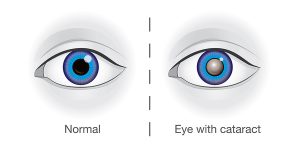
Nội dung bài viết / Table of Contents
This post is also available in: Tiếng Việt (Vietnamese)

A cataract is and eye condition that causes the lens of the eye to be cloudy. For a person with cataracts, it feels like looking through a foggy window. Most cataracts usually develop slowly and may not be bothersome during the early periods. But over time, cataracts can interfere with the eyesight and make it more difficult to drive, read and manage your daily routine activities.
Cataract is a common eye condition that usually affects both men and women over 80 years old. You can reduce your chances of getting cataract by managing your risk factors. Discuss with you doctor for more information.
Cataract can occur in one eye or both eyes but cannot spread from one eye to the other. Some other signs and symptoms may include:
There may be some symptoms not listed above. If you have any concerns about a symptom, please consult your doctor.
You should contact your doctor if you have any of the following:
Everyone’s body acts differently. It is always best to discuss with your doctor what is best for your situation.

The cause of most cataracts is aging or injury that changes the eye tissues. Age-related cataracts may develop in two ways.
The lens of the eye is made up of mostly water and protein. As you age, the lens becomes thicker and less flexible. This causes protein clumps and reduces the light from reaching your retina, which is the light-sensitive layer that is located in the back of your inner eye. This causes the vision to become blurry and dull.
Discoloration of the lens may start as a mild yellow-brown tint but will worsen over time. You may not be able to distinguish the color blue or purple.
There are many risk factors for cataracts, such as:
The information provided is not a substitute for any medical advice. ALWAYS consult with your doctor for more information.
To determine a proper diagnosis, your doctor will evaluate your medical history and perform a comprehensive eye exam. You will be referred to an eye specialist (ophthalmologist), who will perform more tests to determine cataracts.
Treatment is usually not needed if your vision is not impaired. As your vision worsens and you can no longer perform your daily routine activities, the only treatment is surgery.
Cataract surgery is generally safe and may not require hospital stay. There are 2 types of surgery.
During both types of surgery, an artificial lens called an intraocular lens replaces the natural lens. The surgery usually lasts 1 hour and is painless. The doctor will use eye drops to numb the eye and you will be awake the whole time.
The following lifestyles and home remedies might help you cope with cataracts:
If you have any questions, please consult with your doctor to better understand the best solution for you.
Read more posst:
Ferri, Fred. Ferri’s Netter Patient Advisor. Philadelphia, PA: Saunders / Elsevier, 2012. Print version. page 713
Porter, R. S., Kaplan, J. L., Homeier, B. P., & Albert, R. K. (2009). The Merck manual home health handbook. Whitehouse Station, NJ, Merck Research Laboratories. Page 1445
Review Date: January 4, 2017 | Last Modified: January 4, 2017